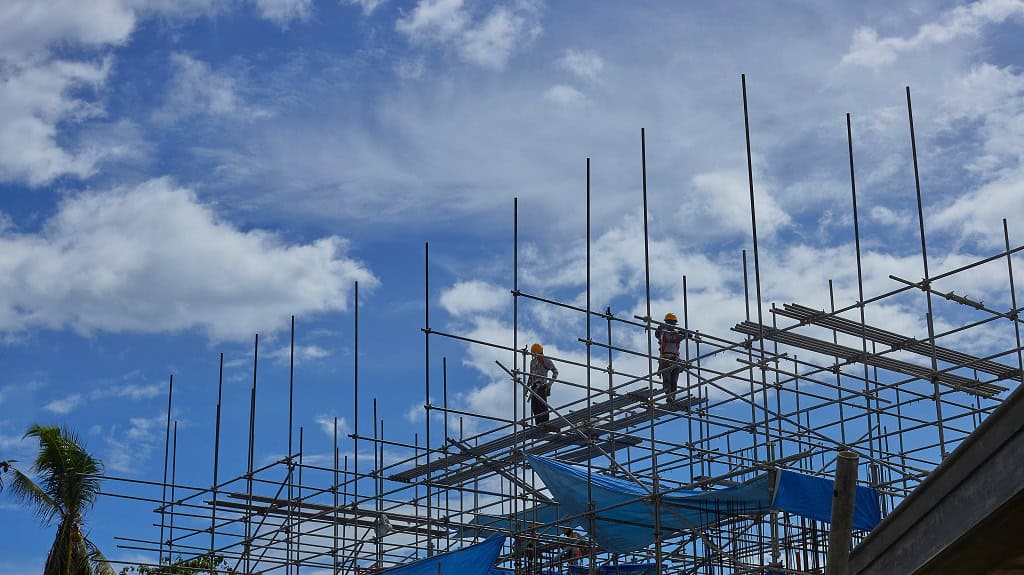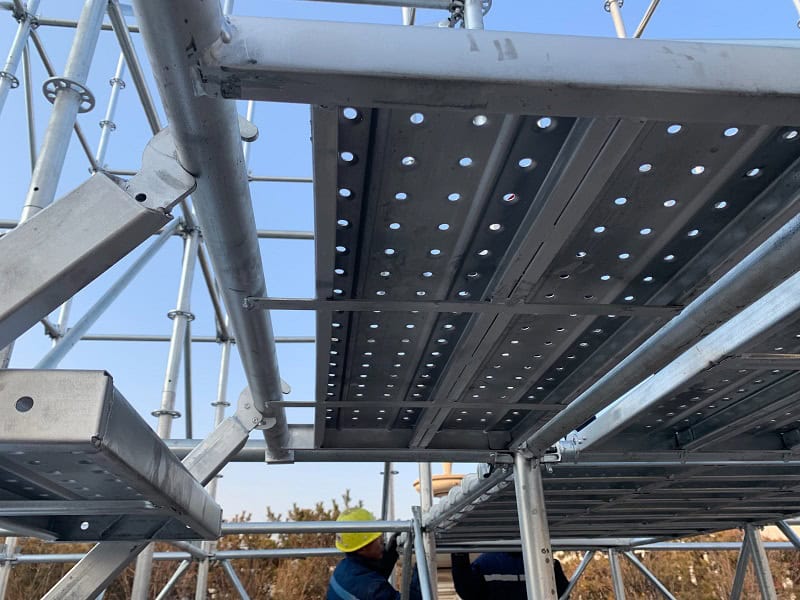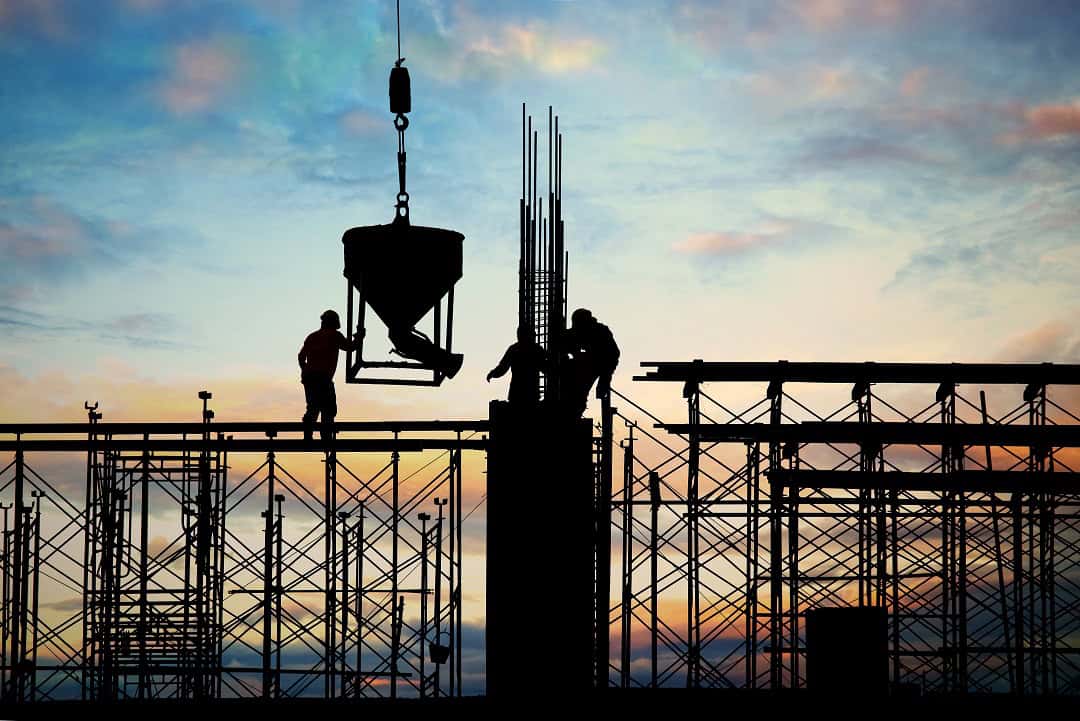Introduction
Les échafaudages sont un élément essentiel de la construction depuis des siècles, des anciennes structures en pierre aux gratte-ciel d'aujourd'hui. Malgré les progrès technologiques, ils restent indispensables. Qu'il s'agisse de construire de nouveaux gratte-ciel, de rénover des bâtiments patrimoniaux ou de procéder à des démolitions complexes, les échafaudages offrent l'accès sécurisé, la stabilité et l'efficacité dont les ouvriers du bâtiment ont besoin.
Dans cet article, nous explorons pourquoi les échafaudages sont essentiels pour le secteur de la construction, soulignons ses avantages et partageons des considérations pratiques pour sélectionner et utiliser le bon système.

Les échafaudages garantissent la sécurité des travailleurs
OSHA et normes de sécurité mondiales
La sécurité est la priorité absolue sur tout chantier. Selon la réglementation OSHA (29 CFR 1926.450b), un échafaudage désigne toute plate-forme surélevée temporaire et sa structure porteuse utilisée pour soutenir les travailleurs ou les matériaux. Les échafaudages doivent être construits pour supporter au moins quatre fois la charge prévue.
Garde-corps, plinthes et protection contre les chutes
Les échafaudages modernes sont conçus dans un souci de sécurité. Parmi leurs caractéristiques, on compte :
- Garde-corps et plinthes pour prévenir les chutes
- Systèmes antichute intégré dans certaines configurations d'échafaudages
- Plateformes stables qui minimisent les glissades et les trébuchements
En réduisant les risques liés aux chutes, principale cause de blessures sur les chantiers de construction, les échafaudages rendent le travail en hauteur beaucoup plus sûr que les échelles ou les plates-formes improvisées.
👉 Explorez davantage : Directives de sécurité sur les chantiers de construction et réglementations OSHA.
Accès facile aux zones difficiles d'accès
Les immeubles de grande hauteur, les grandes façades et les angles difficiles d'accès posent tous des problèmes. Les échafaudages offrent :
- Accès au périmètre complet pour travaux extérieurs
- Plateformes multi-niveaux afin que les travailleurs puissent travailler simultanément
- Conceptions personnalisées (par exemple, échafaudages en porte-à-faux, échafaudages suspendus) pour des structures uniques
Contrairement aux échelles ou aux ascenseurs, les échafaudages permettent aux équipes de travailler à différentes hauteurs en toute stabilité. Cela améliore non seulement la sécurité des travailleurs, mais permet également de gagner du temps en minimisant les temps d'arrêt et les repositionnements.
Gains d'efficacité et de productivité
Les échafaudages contribuent directement à efficacité du projet par:
- Permettre à plusieurs travailleurs d'effectuer des tâches à différentes hauteurs simultanément
- Permettre la libre circulation des matériaux, des outils et des travailleurs
- Réduire les temps d'arrêt causés par un accès limité ou des problèmes de sécurité
Par exemple, la peinture extérieure, le plâtrage ou le revêtement de façade sont plus rapides grâce à la présence d'échafaudages. La surface de travail stable améliore les deux. vitesse et précision.
Flexibilité et adaptabilité dans les projets
Chaque projet de construction présente des défis uniques, mais les systèmes d'échafaudage sont conçus pour s'adapter. Parmi les avantages, on peut citer :
- Conception modulaire – des systèmes comme Ringlock et Cuplock peuvent être assemblés dans d’innombrables configurations
- Montage et démontage rapides – gagner un temps précieux
- Réutilisabilité – les échafaudages de haute qualité peuvent être réutilisés dans plusieurs projets, améliorant ainsi la rentabilité
Qu'il s'agisse de travailler sur un pont, un stade, une tour résidentielle ou une usine industrielle, l'échafaudage s'adapte à différents environnements sans compromettre la sécurité.

Rentabilité et valeur à long terme
Bien que les échafaudages nécessitent un investissement initial, ils offrent des rendements importants :
- Coûts de main d'œuvre réduits – les travailleurs accomplissent leurs tâches plus rapidement
- Moins d'accidents – réduire les frais d’assurance et les temps d’arrêt
- Durabilité – les systèmes d’échafaudages en acier et en aluminium durent des années
Pour les entrepreneurs, l’échafaudage n’est pas seulement une mesure de sécurité, mais aussi un moyen d’améliorer la productivité et la rentabilité.
Conformité aux réglementations de construction
Les réglementations mondiales en matière de construction exigent des plateformes de travail sûres pour les travaux en hauteur. Les échafaudages professionnels garantissent la conformité avec :
- Normes OSHA (États-Unis)
- AS/NZS 1576 (Australie et Nouvelle-Zélande)
- EN 12811 (Europe)
Le non-respect des règles peut entraîner des amendes, des poursuites judiciaires ou des arrêts de travail. L'utilisation d'échafaudages provenant d'un fournisseur réputé garantit la conformité des projets et la protection des travailleurs.
Soutenir la gestion des déchets de construction grâce aux goulottes à débris
Les échafaudages fonctionnent souvent de concert avec chutes de débris Lors de travaux de démolition ou de rénovation, les goulottes offrent :
- Élimination sûre des déchets des étages supérieurs
- Levage manuel réduit, minimiser la tension des travailleurs
- Des sites plus propres et plus sûrs en gardant les voies dégagées
Les systèmes de goulottes à débris, lorsqu'ils sont fixés à un échafaudage, rationalisent la gestion des déchets et améliorent l'efficacité globale du projet.

Comment choisir le bon système d'échafaudage
Lors de la sélection d’un échafaudage, les entrepreneurs doivent tenir compte des éléments suivants :
- Type de projet – immeuble de grande hauteur, résidentiel, industriel ou infrastructurel
- Exigences de charge – poids des travailleurs, des outils et des matériaux
- Durée – location à court terme vs investissement à long terme
- Environnement – conditions météorologiques, espaces confinés ou terrain accidenté
Les types d’échafaudages courants comprennent :
- Échafaudage Ringlock – modulaire, polyvalent et facile à assembler
- Échafaudage Cuplock – système de verrouillage rapide, populaire pour les projets à grande échelle
- Échafaudages à cadre – simple et économique, idéal pour les travaux résidentiels ou commerciaux de petite taille
Points clés à retenir
- La sécurité avant tout – l’échafaudage prévient les chutes et répond aux normes réglementaires.
- Accès amélioré – il est plus facile d’atteindre des zones complexes ou surélevées.
- Efficacité accrue – plusieurs corps de métier peuvent travailler simultanément.
- Flexible et adaptable – adapté à différents types de projets.
- Rentable – permet de réduire les coûts de main-d’œuvre et de garantir un retour sur investissement à long terme.
L'échafaudage reste un partie non négociable de la construction moderne, garantissant que les projets sont livrés de manière sûre, efficace et dans les délais.
FAQ
Pourquoi l’échafaudage est-il meilleur que les échelles ?
Les échelles offrent un accès et une stabilité limités. Les échafaudages offrent des plateformes sécurisées, des garde-corps et permettent à plusieurs travailleurs de travailler en hauteur en toute sécurité.
Quel est le type d’échafaudage le plus courant ?
Les échafaudages à cadre sont largement utilisés pour les projets résidentiels et commerciaux de petite taille, tandis que les systèmes Ringlock et Cuplock sont courants dans les constructions à grande échelle et complexes.
À quelle fréquence les échafaudages doivent-ils être inspectés ?
Les échafaudages doivent être inspectés avant utilisation, après toute modification et régulièrement tout au long du projet, conformément aux normes de sécurité OSHA ou locales.
Les échafaudages peuvent-ils permettre de réduire les coûts de construction ?
Oui. En améliorant l'efficacité, en réduisant les temps d'arrêt et en prévenant les accidents, les échafaudages contribuent à réduire les coûts de main-d'œuvre et d'assurance.
Les systèmes d’échafaudage fonctionnent-ils avec des goulottes à débris ?
Oui. Les chutes à débris sont souvent fixées aux échafaudages, permettant une élimination sûre et efficace des déchets en hauteur.





